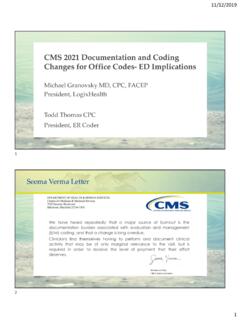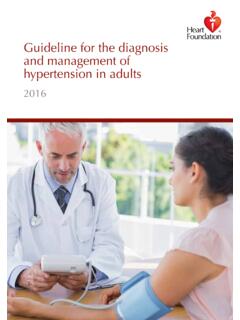Transcription of Complications of the Transcatheter Aortic Valve Replacement
1 3/8/20211 Complications of Transcatheter Aortic Valve ReplacementBRADFORD L. WALTERS, MD, FACEPWILLIAM BEAUMONT HOSPITAL, DEPARTMENT OF EMERGENCY MEDICINEROYAL OAK, MICHIGANC onflicts of Interest NONE!!!!!!123/8/20212 Aortic Stenosis Incidence Aortic stenosis (AS) is one of the most common degenerative valvular diseases by far. The population is aging with recent estimates of Aortic Valve disease prevalence of in persons from 65-74 years old and in those older than 75. Open surgical Replacement was the standard treatment but, it entails a major surgical procedure and is not available to a sizeable proportion of AS patients due to co-morbidities.
2 The TAVR procedure has been available since 2002 and 5-year data has shown a better survival outcome over surgically replaced valves but, was only indicated in the segment of the population with AS that could not undergo surgical Replacement . What is the TAVR The Transcatheter Aortic Valve Replacement (TAVR) is a minimally invasive method to replace the Aortic Valve typically due to Aortic stenosis. It is performed by one of three approaches : Via the femoral artery like a cardiac catheterization. Transapically by being inserted through the left ventricular apex.
3 Transaortic approach through the aorta just above the Aortic Valve . The native Valve is dilated using a balloon valvuloplasty and then a second balloon with the folded up Replacement Valve is inserted and allowed to open up over the native Valve . As of August of 2019 it is now indicated even in patients at low risk of Complications from a surgical Valve Replacement approaches The transfemoral approach is the one typically used by a cardiologist with the transaortic and transapical approaches the providence of the cardiothoracic Key Part of the ProcedureThe key part of the procedure involves the final deployment of the Valve as the balloon inflates against the already flattened native Valve .
4 It then opens up with the Replacement artificial Valve now in place. The new Valve has to be precisely situated and angled correctly. Easy to do in a picture, a bit trickier in real life. 563/8/20214 TAVR Risks Transcatheter Aortic Valve Replacement (TAVR) carries a risk of Complications , which may include: Bleeding procedural, due to post-placement anticoagulation Blood vessel Complications Problems with the Replacement Valve , such as the Valve slipping out of place or leaking Stroke Heart rhythm abnormalities (arrhythmias) Kidney disease from the IV contrast used during the procedure Myocardial infarction Infection DeathTAVR Risks Clearly some of the cited Complications /risks are not of concern in the ED that would occur during the procedure.
5 However, any of those so cited could potentially occur either post-procedure or not seen during the procedure. Having a familiarity of the procedure and the type of approach can give the emergency physician idea of what to expect: Trans-apical approach can cause cardiac tamponade, most typically noted at the time of the procedure but with anticoagulation might be delayed. Valve malalignment or failure to deploy is also almost always noted at the time of the procedure and unlikely to be an issue that presents to the Risks -Bleeding Peri-procedural bleeding is generally picked up immediately during or just after the procedure.
6 However, post-procedure anticoagulation places the patient at all the risks that are so commonly seen in any anticoagulated person. The initial studies used antiplatelet agents starting with just ASA and then progressing to dual-agent regimens ASA + clopidogrel. Given that a fair number of TAVR patients are frail there is an increased risk of bleeding Complications estimated at 16% + The ARTE study comparing ASA with ASA/Plavix regimens found an odds ratio of bleeding of in the dual platelet inhibitor group with an equal mortality between the two groups.
7 TAVR Risks -Bleeding The need for anticoagulation is to prevent Valve leaflet thickening due to blood clotting on the leaflet causing Valve malfunction, embolus, or a nidus of infection. With improved imaging leaflet thickening has been demonstrated in a concerning 13% of TAVR patients on dual- antiplatelet therapy . There is growing opinion to increase the anticoagulation regimen post-TAVR to using either a VKA or DOAC. Clearly the DOAC s are superior in efficacy and safety compared to coumadin but not approved for Valve Replacement . In a small study of 21 TAVR patients at Mayo Clinic of which 92% were on a DOAC for atrial fibrillation or flutter the results were that the DOAC was well tolerated with only 2 patients experiencing a bleeding event and no thromboembolic events reported 1/3 of TAVR patients have a history of atrial fibrillation.
8 Still these patients are going to fall, have spontaneous bleeding, or need an emergency procedure post-TAVR all of which will fall to the emergency physician to manage. 9103/8/20216 TAVR Risks Blood Vessel Injury Typically Complications of the procedure due to injury of a blood vessel are noted at the time or just after the procedure. The catheters used to place a TAVR are quite large so the femoral artery approach is the one used by cardiologists. AV fistulas and thrombosis of the femoral artery can occur in a similar manner to such Complications post-cardiac catheterization.
9 Aortic injury or direct injury to the heart with the transapical or transaortic approaches are almost always seen right at the time of the procedure and unlikely to present to the Risks Valve Issues Failure of the Valve to deploy, function, or mispositioned are almost always seen at the time of the procedure such as too low or too high implantation. Valve regurgitation can be seen immediately or later, potentially in the ED symptoms can include fatigue, chest pain, syncope, or dyspnea. A new murmur might be detected on exam but, typically knowing that a patient has a murmur previously might not be known in the ED.
10 Treatment in the ED includes stabilizing the patient, pressors to maintain prefusion, transthoracic echocardiology can be helpful, and immediate notification of cardiology/CV Risks -Stroke Heart Valve disease is associated with stroke whether the native diseased Valve is left in place, an allograph bovine or porcine Valve is placed, or a mechanical Valve is used such as the TAVR. Mainly due to debris from the Valve breaking off. antiplatelet and anticoagulation has reduced the incidence but, has its own inherent risks of bleeding. In the early TAVR trials the risk of stroke was + , not an inconsiderable incidence particularly as the number of patients undergoing this procedure increases.


